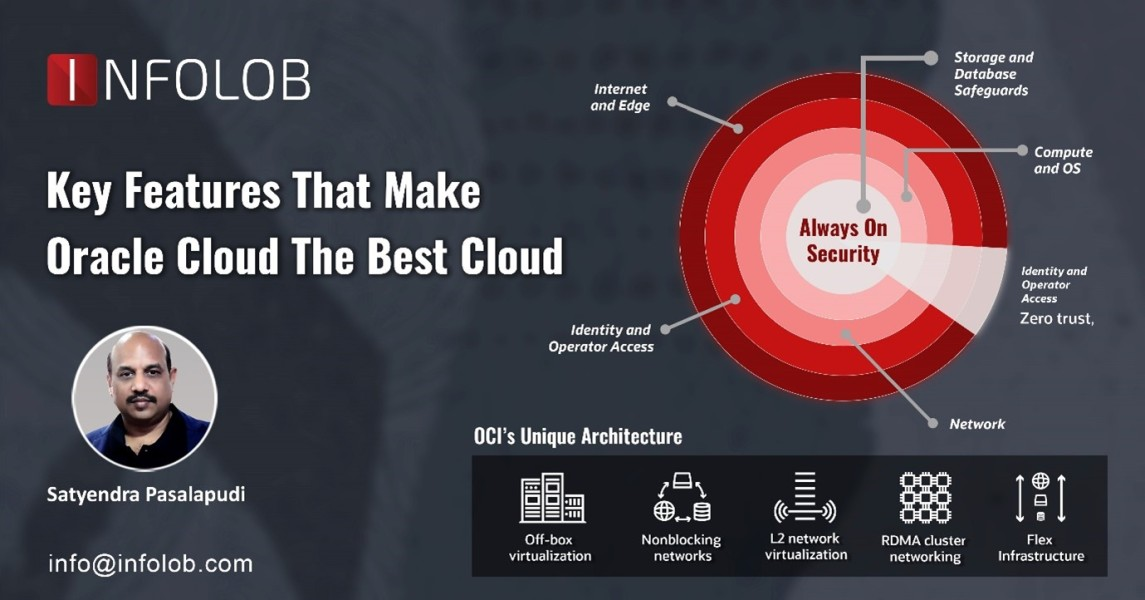Adjoining the innovation crux, Oracle Cloud Infrastructure (OCI) has global scale. Oracle Cloud became a storming wave across industries for cutting the complexities such as application latency with performance, need for global footprint, security, and compliance risks, etc. Thanks to the Oracle’s strong legacy where it has sledged all these complexities and delivered significant outcomes for enterprises.
Sprouted in 2016, delivering 100-plus cloud services supporting more than a thousand government customers and tens of thousands of enterprise customers, Oracle’s second-generation cloud, Oracle Cloud Infrastructure is architected to handle end-to-end mission-critical cloud workloads. Spreading across to more than 60 datacenters with another 100 in pipeline, OCI continued its legacy on a global scale with 48 public cloud regions across 24 countries.
In addition, Oracle also plans to maximize this footprint and enable OCI to deploy new regions of any size and scale up when needed by relying on the architecture of OCI’s public cloud regions. Further, each OCI region is identical in terms of infrastructure, connectivity, security and portfolio of services. This is important for customers deploying workloads and applications across multiple regions.
For the customers who face unique challenges in terms of application latency or data locality, Oracle has developed a set of unique OCI offerings. Within the Oracle Cloud@Customer portfolio of solutions, consisting of Exadata Cloud@Customer and Compute Cloud@Customer, Oracle deploys rack-level cloud infrastructure at the location of a customer’s choice. However, Oracle Cloud@Customer is deployed and managed entirely by OCI, enabling the customers to take the fill advantage of the cloud experience on-premises.
Another example is OCI Dedicated Region which delivers a fully self-contained cloud region in the customer’s datacenter or a location of their choice. This is for customers who have the tailored requirements around security, regulations and data locality at scale. Like Oracle Cloud@Customer, OCI handles deployment, support, and operations of the environment while customer can use the services thereby reducing their OPEX.
Since its evolution, OCI has bolstered its portfolio of cloud offerings with new products in 2023 and these include:
- Oracle EU Sovereign Cloud: OCI cloud regions located only within the geographical space of the EU – to be used by private and public sector organizations.
- Oracle Databsse@Azure: A partnership between Microsoft and Oracle where Oracle databases that run on OCI hardware are physically installed in Azure datacenters and managed as an Azure service.
- OCI Generative AI Service: An OCI managed service enabling AI across a wide variety of use cases through an LLM API interface.
- OCI Supercluster: A service that offers bare-metal infrastructure and high-speed networking required to run HPC and AI workloads.
- MySQL HeatWave Lakehouse: An OCI service that allows customers to query data in a variety of storage formats and automatically build and train ML models. This service is available on OCI, AWS, and Azure.
- Oracle Database 23c Free: A fully featured, entry-level database that helps customers and developers deploy on Oracle database environments.
Why Industries Adapt OCI to Foster Innovation & Scalability?
With a focus to transform core engineering systems to be cloud ready, OCI have accelerated operational excellence and business value. There are seven key reasons why enterprises adapt Oracle Cloud Infrastructure (OCI) for all their workloads.
- Unicorns & Established Enterprises Became Cloud-native
Since its evolution in 2023, our OCI has boasted a very impressive customer list. The enterprises have span across the globe – ranging from local to some of the largest multinationals. Leveraging the Oracle Cloud, each of these multinationals have thousands of other customers who utilize it for end-to-end operations.
Having these customers is remarkable in Oracle’s history. Another interesting aspect is how OCI is attracting cloud-native unicorns that keep on rising from nowhere. A great example of this is Uber. Uber has utilized OCI to foster innovation, help deliver new products to market that resulted in increased profitability.
Leveraging Oracle in the retail space enables to better manage the last mile of delivery between its retail partners and customers. It’s observed that the Oracle Cloud has allowed enterprises to scale their products, resulting in the growth by 100% in one year.
- OCI Solved Control Plane Glitch in Most Hyper Scalers
Oracle spotted the unnecessary vulnerability of running the control plane on the servers for customer tenancy workloads. It offered a freeway for unauthorized entities to exploit a privilege or misconfiguration within the operating system or application within a given tenancy. This exploitation could potentially lead to unauthorized access to the shared control plane software.
Plus, the practice of running the control plane on the same hardware as the server had limitations like hindering the ability to allocate the complete server performance to a client and preventing secure encryption that would grant the client control over the entire system, including the VM’s keys.
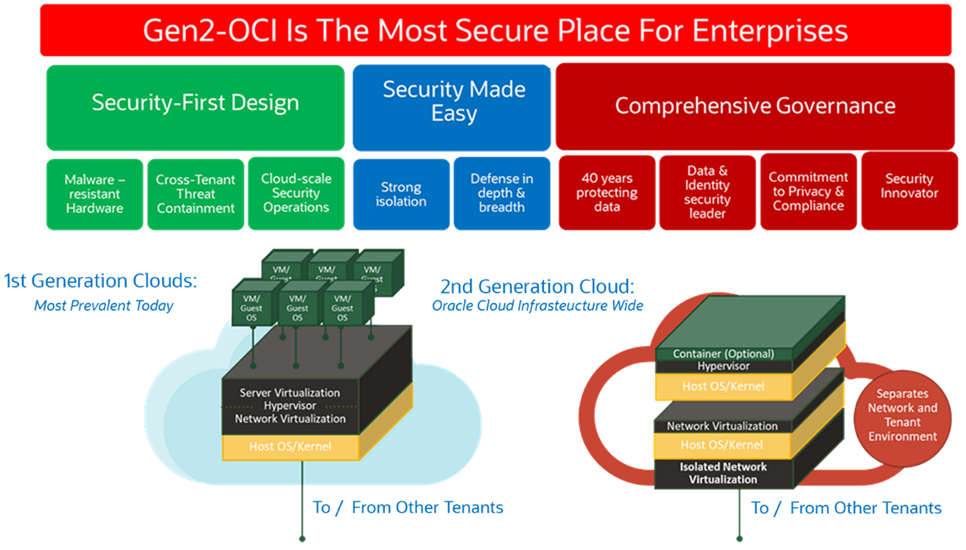
To tackle this challenge, Oracle introduced the off-box control plane DPU responsible for managing service provisioning on OCI. This innovative approach not only empowers Oracle to provide customers with automated access to complete bare-metal servers but also grants customers ownership of encryption keys for the entire server infrastructure. Importantly, this off-box control plane also securely administers VMs, containers, serverless instances, and various PaaS services. Oracle made all that possible for the first time since the cloud’s inception.
- Product and Service Innovation
Coming to the innovation, OCI’s AI infrastructure leads the industry in price-for-performance through the OCI supercluster that;s designed specifically for training machine learning applications such as generative AI. This became possible because of engineering relationship that Oracle has made with Nvidia.
Another great example for OCI gaining traction through innovation is Oracle Alloy. It’s a platform that enables partners of all sizes to build and deliver cloud services to their customers quickly. Be it an ISV or MSP supporting a customer base with unique regulations, Alloy allows these organizations to brand their cloud services while OCI running at the backend.
- Oracle Cloud’s Performance Value Outweighing the Rest
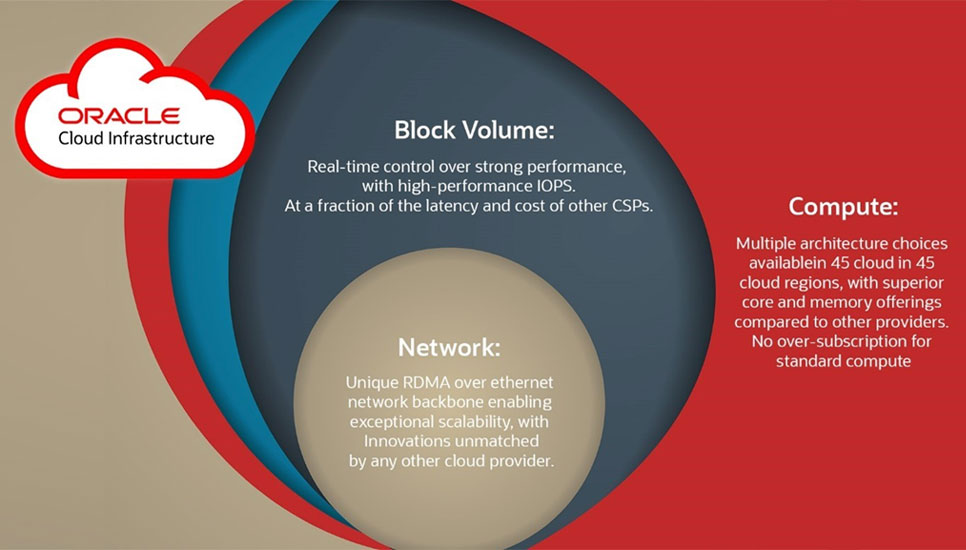
- OCI is Why Cloud Remains Safe
OCI realized this by powering up the fundamental security measures first, birthing security innovations next, followed by fusing with industry-leading practices. For example:
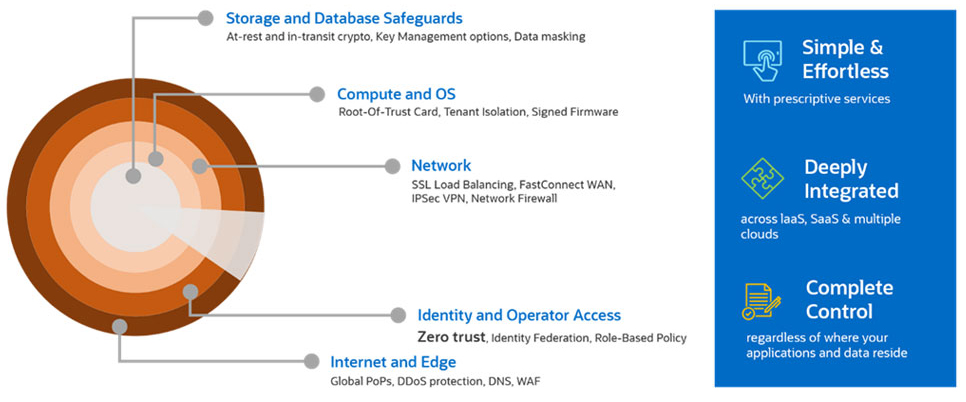
- With physically isolated tenancies and actively managed security postures, OCI offers enhanced protection.
- Every compute resource undergoes a thorough cleaning process and reboots with a root of trust card, guaranteeing the absence of any lingering software remnants from previous users
- Identity and Access are seamlessly integrated across IaaS, SaaS, and multi-cloud environments, facilitated through a unified control plane for simplified management
- Customers on OCI experience a security-focused approach without compromising on cost, focusing on simplicity, integration, and comprehensive control across data and application locations
- Oracle Cloud is Open and Offers Innovation-edge via LLMs
OCI supports a range of workloads, including major applications like Amdocs for leading companies and SAP and Netweaver instances for various organizations. Successful migrations from Azure to OCI have been observed, such as with the Diksha education platform, resulting in improved price performance. Noteworthy projects, including the India National Stock Exchange’s management of LIC’s largest IPO, have chosen OCI, while collaborations with Microsoft enable seamless integration of various Windows services.
The cloud ecosystem must cope up with evolutionary innovations and have the potential to adapt Large Language Models (LLMS) such as generative AI and machine learning algorithms. In our expertise, we have seen how OCI has transformed the industries with its unique AI and machine learning capabilities automating and solving most complex business challenges seamlessly.
On the other hand, OCI greatly supports LLMs support high-performance GPU environments, maintaining low-latency networks. Indeed, AI/ML models have become key spinners of OCI’s adoption on a global scale. Moreover, LLMs drive the innovations inside Oracle Cloud environments, aligning to high security and compliance standards.
Plus, OCI caters to diverse AI/ML workloads, serving clients with a range of applications including LLM Generative AI models, TensorFlow, CFD simulations, and more.
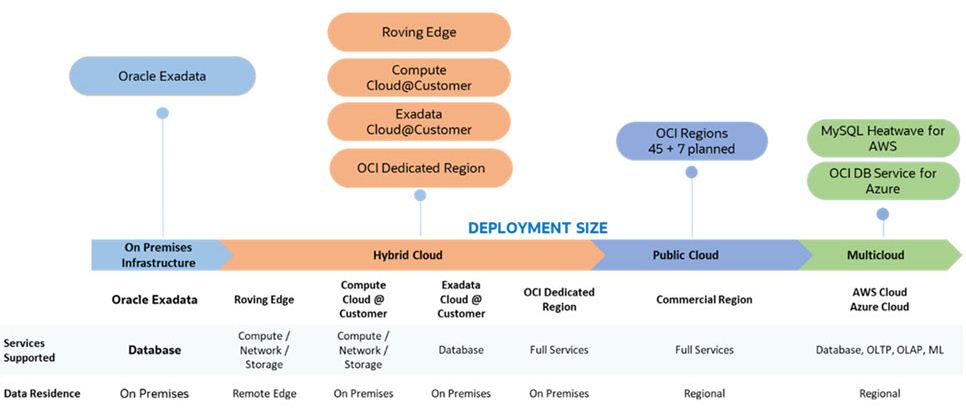
OCI’s distributed cloud approach meets you at every stage of your cloud journey. Whether it is for addressing latency and data residency concerns by bringing the cloud to your data center, focusing on the database tier through Exadata Cloud at Customer, or bringing the entire Oracle cloud behind your firewall via the Dedicated Region, OCI offers tailored solutions to match your specific needs and requirements.
- Value-driven partnerships at scale
Oracle and its partnerships have made significant value creation since a few years. Although Oracle had the best data management platform for decades, it was less focused on building tech-level partnerships. But OCI takes a different stand in the company’s approach to partnerships. It’s observed that Cloud organizations can excel only if they are open and willing to embrace the ecosystem to deliver a differentiated customer experience.
In 2023, we have seen OCI deepen its partnerships with companies such as Nvidia, Microsoft, VMWare, and Red Hat so that customers have the flexibility to choose the best-of-breed technologies in the cloud. Moreover, to drive multi-cloud experience, Oracle Database@Azure and Oracle Interconnect for Azure states the deep engineering collaboration, establishing a win-win scenario for everyone.
Another major advantage for OCI is the bare metal instances of Nvidia that’s industry-leading performant and security with great flexibility. Nvidia partnership has taken the OCI to handle high performance computing environments with less disruptions as it comes with H100 GPUs and supports AI algorithms intensely.
These are just a few examples of how OCI and partnerships are meeting the needs of its customers and it’s not surprising that Oracle Cloud now supports 1.5 million developers worldwide.
- Oracle Cloud Solved Vertical Scaling in Hyperclouds
Oracle’s rack design strategy converged on advancing the vertical scalability of systems via cluster networking. Oracle Cloud Infrastructure’s seamlessly integrated remote direct memory access (RDMA) over converged Ethernet backplanes into their Intel and AMD server systems, empowering automated clustering capabilities between servers.
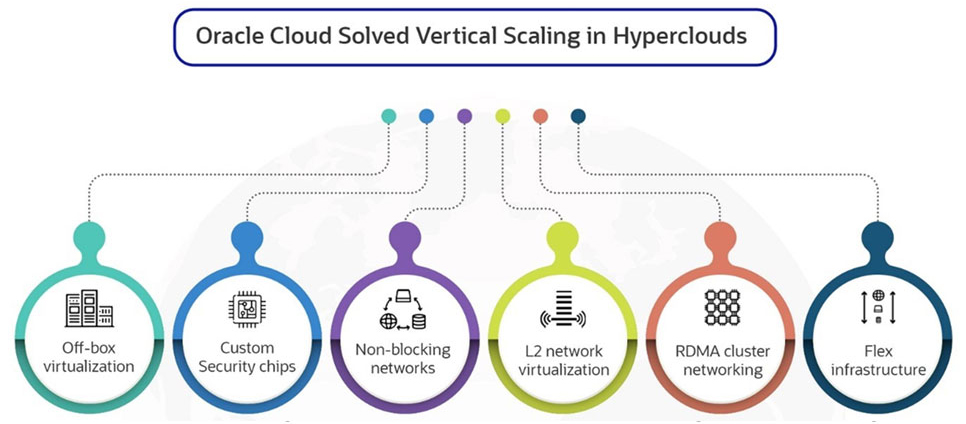
Furthermore, Oracle Cloud’s capacity to provide automated clustered bare-metal services, coupled with Layer 2 network virtualization, positions Oracle as the sole provider offering a complete VMware service with native support for, vRealize, NSX, and vSAN. This compatibility extends to third-party tools and hypervisor versions, ensuring seamless integration with on-premises VMware environments and swift migrations.
In essence, this approach has engendered a cloud architecture that adeptly caters to the demands of both contemporary horizontally scaling cloud-native systems and the performance prerequisites of finely tuned, unified, stateful enterprise applications and environments at zero trade-offs.
Getting Down to Activating Cloud Economics
As a cutting-edge and perspicacious CIO, one must be well-versed in the intricacies of cloud economics. The fundamental concept of cloud economics revolves around the optimization of cost-effectiveness, efficiency, and scalability, which can be achieved through a comprehensive understanding of the underlying factors that govern the cloud and render it profitable. For instance:
To begin with, CIOs must carefully analyze their business requirements and select the appropriate cloud deployment model that aligns with their goals. Whether it be a public, private, or hybrid cloud, each model has its unique cost structure that must be evaluated to ensure optimal cost-efficiency. Additionally, the CIO must evaluate various pricing models, such as pay-as-you-go, subscription-based, and spot instances, to determine the most cost-effective option.
Taking Care of Cost Detours While Putting Cloud-Native Era to Work
Moreover, CIOs must take into account the ongoing maintenance costs associated with cloud infrastructure, which can accrue over time and become a giant expense. By adopting a proactive approach to cloud cost management, CIOs can avoid unforeseen expenses and optimize their investments in the long run.
Another crucial aspect of cloud economics is the ability to leverage cloud-native tools and technologies to reduce operational costs and improve efficiency. Cloud-based automation and orchestration tools enable businesses to streamline their operations and achieve higher levels of efficiency, ultimately reducing costs.
To sum up, cloud economics is an indispensable domain for modern CIOs, who must navigate the complex landscape of the cloud-native era to decipher optimal cost-effectiveness and scalability. By staying abreast of the latest cloud economics trends and exploiting cloud-native tools and technologies, CIOs can unlock the unparalleled potential of the cloud and shepherd prosperity through re-calibrated TCO and ROI.
For all cloud adoption and management, please write to:

